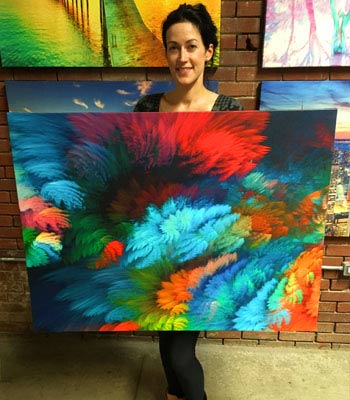Canvas printing and screen printing are two popular techniques for creating visually appealing artworks and designs. In this article, we will delve into the nuances of canvas printing on HP printers with pigment ink and compare it to the traditional method of screen printing.
Introduction
Canvas printing has gained immense popularity in recent years due to its ability to transform digital images into beautiful, tangible pieces of art. Meanwhile, screen printing has been a staple in the printing industry for decades. Both methods have their own merits and demerits, and understanding the differences between canvas printing on HP printers with pigment ink and screen printing can help artists and enthusiasts make informed decisions based on their specific needs.
Canvas Printing on HP Printers with Pigment Ink
Canvas printing on HP printers with pigment ink combines the precision of modern digital printing technology with the aesthetic appeal of canvas material. Pigment ink, known for its longevity and color accuracy, plays a significant role in the quality of the final print.
Advantages:
- Color Accuracy: HP printers with pigment ink offer exceptional color accuracy, allowing artists to reproduce their digital creations with remarkable fidelity.
- Longevity: Pigment ink is known for its resistance to fading, making canvas prints suitable for long-term display without compromising their vibrancy.
- Detail and Resolution: HP printers are capable of producing high-resolution prints with intricate details, enhancing the overall visual appeal of canvas artwork.
Limitations:
- Cost: The initial investment in an HP printer and quality pigment inks can be relatively high, particularly for individual artists or small-scale businesses.
- Size Restrictions: The size of the canvas print is limited to the dimensions of the printer, which may be a drawback for artists who require larger formats.
Screen Printing
Screen printing, also known as silk screening, involves transferring ink onto a canvas through a mesh screen. It is a traditional technique that has been used for various artistic and commercial applications.
Advantages:
- Versatility: Screen printing can be performed on a wide range of surfaces beyond canvas, including textiles, paper, and even wood.
- Cost-Effective for Bulk: In cases where multiple copies of the same design are required, screen printing can be more cost-effective than individual canvas printing.
- Texture and Depth: Screen printing can achieve a unique texture and depth due to the ink buildup, creating a tactile and visually interesting artwork.
Limitations:
- Complex Designs: Intricate designs with fine details may be challenging to reproduce accurately through screen printing, leading to potential loss of fidelity.
- Labor-Intensive: The screen preparation process and manual printing can be time-consuming and labor-intensive, especially for large prints.
- Color Limitations: Achieving a wide color gamut and color gradients can be more challenging in screen printing compared to digital canvas printing.
Comparison
- Image Quality: Canvas printing on HP printers with pigment ink generally offers superior image quality with precise color reproduction and sharp details. Screen printing can struggle with intricate designs and fine details.
- Color Range: HP printers with pigment ink provide a broader color range and better color gradients, making them suitable for reproducing a wide variety of images. Screen printing may have limitations in achieving certain colors and gradients.
- Durability: Pigment ink is highly resistant to fading, giving canvas prints a longer lifespan. Screen printing inks may fade over time, especially when exposed to UV light.
- Versatility: While canvas printing is limited to canvas material, screen printing can be applied to various surfaces, offering greater versatility in terms of artistic expression.
- Cost: Canvas printing on HP printers can be cost-effective for individual prints or small quantities. Screen printing becomes more economical when producing a large number of copies.
- Texture and Feel: Screen printing creates a unique texture due to the ink buildup, offering a tactile quality that canvas printing lacks.
Conclusion
Both canvas printing on HP printers with pigment ink and screen printing have their own strengths and weaknesses. The choice between the two depends on factors such as image complexity, quantity needed, desired texture, and budget. Canvas printing with pigment ink excels in color accuracy and image longevity, making it ideal for individual artists and high-quality reproductions. On the other hand, screen printing offers versatility in terms of surfaces, making it a popular choice for commercial applications and bulk printing. Artists and businesses can make informed decisions by weighing these factors against their specific requirements and preferences.
